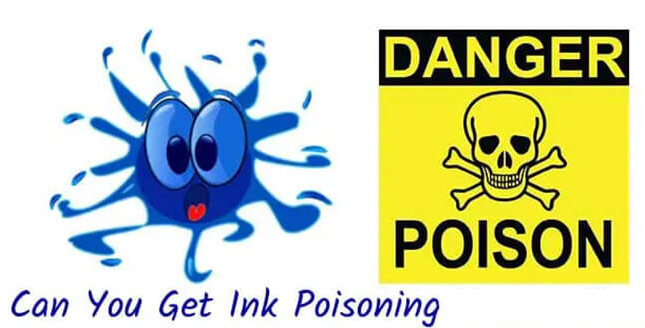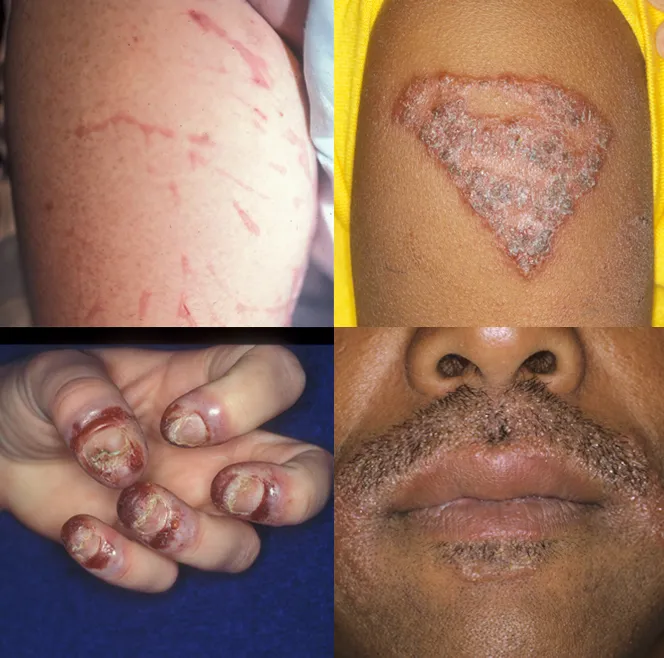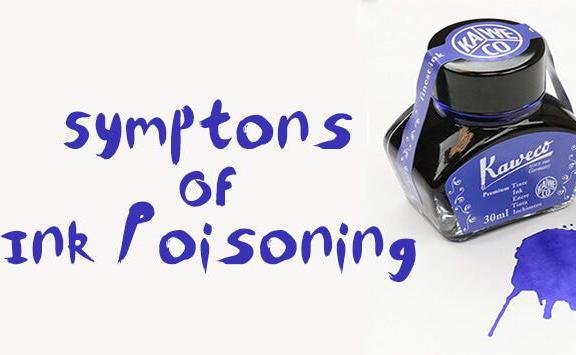The Ink Poisoning Symptoms can vary from minor irritability to serious health issues. Even though ink poisoning is usually not fatal, it is still important to take the right precautions, particularly if consuming a lot of ink or developing infections linked to tattoo ink. It is imperative that you use reputable ink manufacturers who use gamma radiation to kill microorganisms in the ink and its packaging, and that you ask a cosmetologist or tattoo artist about the ingredients in the ink that will be injected into your skin.
What is Ink Poisoning:
When someone eats ink from pens, markers, or highlighters, they can get ink poisoning. It can irritate eyes, produce stains on skin and mucous membranes, and upset the stomach. Larger amounts can be hazardous, but smaller amounts are typically not toxic.

Fast medical attention :
Fast medical attention is essential for healing. Ink exposure can cause eye irritation, but drawing on skin does not result in ink poisoning. Tattoo ink poisoning emphasizes how crucial cleanliness and safety are during tattoo processes to avoid infections from tainted ink.
- Swallowing ink from writing instruments, like pens, can result in writing ink poisoning. Composed of a mixture of dyes, pigments, solvents, and water, writing ink is usually regarded as non-toxic. Skin and mucous membrane discolorations, as well as irritation of the eyes, are among the symptoms. But before therapy is required, a significant amount of writing ink—more than an ounce or thirty milliliters—must be consumed.
- Poisoning from Fountain Pen Ink: This kind of poisoning is exclusive to the ink that is used in fountain pens. Writing ink intended to flow continuously and smoothly from a fountain pen is known as fountain pen ink. Although it is generally thought to be nonpoisonous, large doses must be ingested before medical attention is required.
- Printer Ink Poisoning: The ink used in printers is the specific cause of this kind of poisoning. One kind of ink called printer ink is made specifically to be used in printers to print documents of the highest quality. It is usually more concentrated than writing ink, and if taken in large amounts, it could result in more severe side effects.
- Tattoo Ink Poisoning: The ink used in tattoos is the specific source of this kind of poisoning. One kind of ink intended for skin injection to produce a permanent tattoo is called tattoo ink. It is usually more concentrated than writing ink, and if swallowed or if it becomes infected, it could result in more severe symptoms.
Typical Causes of Poisoning from Ink:
- Ingestion of Writing Ink:
- Swallowing ink from writing instruments such as pens can result in writing ink poisoning.
- The mixture of dyes, pigments, solvents, and water that makes up writing ink is usually regarded as nonpoisonous.
- Ink Poisoning Symptoms include eye irritation, staining of skin and mucous membranes, and mild stomach upset.
- Before treatment is required, a significant amount of writing ink (more than an ounce or thirty milliliters) must be consumed.
- Taking in tattoo ink:
- If tattoo ink is swallowed or gets infected, it can result in tattoo ink poisoning.
- Unsafe industrial and automotive paints are present in some tattoo inks.
- Ink poisoning from tattoos can cause blisters, rashes, sore nodules, and deep abscesses.
- Tattoo ink tainted with nontuberculous mycobacteria (NTM) is a common source of bacteria.
- Skin or eye exposure:
- Itching, burning, and irritation can result from getting ink in the skin or eyes.
- The best way to get rid of ink is to rinse your eyes or skin with cool water.
- Although ink can momentarily stain the skin, mucous membranes, or eyes, long-term problems are unlikely to result from it.
- Seek medical attention if irritation or blurred vision continue after being exposed to ink.
- Unintentional Consumption:
- Although ink is not usually poisonous, accidental ingestion can cause mild symptoms such as irritation.
- Ingesting small amounts of ink is unlikely to result in poisoning, as it is generally safe.
- Large amounts of ink are typically the cause of ink poisoning from accidental ingestion, though it is rarely fatal.
- Staining of mouth tissues and nausea are signs of ink poisoning from ingestion.
Signs of Poisoning with Ink

- Irritation of the eyes: Ink can cause irritation and blurriness of the vision. Rinse the eyes with cool water and consult a doctor if necessary.
- Skin and mucous membrane staining: Ink may momentarily stain skin or mucous membranes, but long-term or irreversible problems are unlikely to result from it.
- Nausea or stomach ache: If a significant amount of ink is swallowed, mild symptoms like nausea or stomach ache may occur.
Quick Moves
- Dial your local emergency number (such as 911) right away if the person is unconscious, having trouble breathing, or exhibiting other symptoms of distress.
- Avoid Causing Vomiting: Never cause someone to throw up unless instructed to do so by a medical professional or the poison control center.
- Take Off Clothes and Wash Skin: Give the skin a thorough 15 minutes of water rinsing if the ink is still present.
- Rinse Eyes with Water: Give your eyes a minimum of 15 minutes of water treatment if ink gets inside of them.
- Get Medical Help: Even if someone seems fine, you should still get them checked out as soon as possible.
- Provide Specifics: Have the following information on hand when you call the poison control center or a medical professional: Age, weight, and state of the individual
Before treatment is required, a significant amount of writing ink (more than an ounce or thirty milliliters) must be consumed. Nevertheless, since symptoms differ from person to person, it is still critical to get medical attention.
Options for Treatment
The type of ink contaminated and the severity of the symptoms determine the course of treatment for ink poisoning. It is critical to seek medical attention as soon as possible to treat ink poisoning. It is advised to get in touch with a medical professional or a poison control center right away if someone has consumed a sizable amount of ink or is exhibiting signs of ink poisoning, such as eye irritation, skin or mucous membrane staining, or stomach pain. The medical professional can offer advice on what to do next, including checking vital signs, cleaning the ink-stained areas, and evaluating the patient’s condition to see if more treatment is required. It is crucial to follow medical advice and refrain from inducing vomiting.
Preventive Actions
It is essential to adhere to these precautions in order to prevent ink poisoning:
- Writing instruments and ink should be kept out of children’s and animals’ reach.
- Pen and marker tips should not be chewed on or sucked on.
- Never, ever consume ink, even in tiny amounts.
- In the event that ink inadvertently gets in your eyes, thoroughly wash them with cool water.
- Use soap and water to remove ink from your skin if it gets on it.
- Choose trustworthy ink producers who eliminate microorganisms from their ink and packaging using gamma radiation.
- Inquire with the tattoo artist about the components of the ink that will be injected into your skin if you are getting one.
- Seek medical assistance right away if you experience any ink poisoning symptoms, such as stomach pain, skin or mucous membrane discoloration, or irritation of the eyes.
- In the event that you believe someone has consumed a sizable quantity of ink, get in touch with a poison control center or a medical expert right away.
- Avoid forcing yourself to throw up unless a medical professional tells you to.
You can lessen your chance of developing ink poisoning and make sure that you and those around you are safe by taking these precautions.
Safety Measures
- To avoid unintentional ingestion, wash your hands before and after handling products that contain ink.
- Keep ink products separate from food and drink items in the refrigerator.
- When using high-pressure washers, put on safety gear, such as face shields, to keep ink splashes out of your mouth and eyes.
- When handling inks, follow safe working procedures and maintain good industrial hygiene.
- Since both solvent-based and UV inks can be harmful to your health, handle them with caution.
- Avoid getting solvents and harsh cleansers on your skin or eyes, as this can strip natural oils and lead to dermatitis.
- The cycle of exposure, dryness, and dermatitis should not be repeated, as this can cause skin sensitization.
- Keep ink supplies out of children’s and animals’ reach.
- In the event of an allergic reaction, heed the manufacturer’s safety instructions and seek professional advice.
Factors of Risk
Large ink consumption—more than an ounce or thirty milliliters—having underlying medical conditions, or being pregnant, are risk factors for ink poisoning. Large ink intakes can cause symptoms like nausea, stomachaches, and discoloration of the oral tissues. Tattoo ink and permanent makeup can also be dangerous to ingest since some inks contain unsafe industrial and automotive ink paints. It is crucial to inquire about the components of the ink that will be injected into the skin from a cosmetologist or tattoo artist. Furthermore, if ink gets on the skin or in the eyes, it can irritate those areas, so it is important to rinse them with cool water. It is also critical to remember that, despite being unlikely, ink poisoning can still happen, so if symptoms appear, you should definitely get medical help.
FAQs
- Can a person die from ink poisoning?
Ink poisoning can have serious side effects that require medical attention, even though it is rarely fatal.
- If ink gets in my eyes, what should I do?
If irritation continues, rinse your eyes with water and see a doctor.
- Is tattoo ink hazardous?
The fact that some tattoo inks contain hazardous materials highlights how crucial sterile tattooing techniques are.
- Can ink poisoning affect children?
It is true that kids are at risk, so keep ink products out of their hands.
- What signs of ink poisoning are present?
Seek medical attention if symptoms such as stomach distress, skin discolorations, and eye irritation occur.
Conclusion
Even though Ink Poisoning Symptoms rarely results in death, it can cause discomfort and health issues if left untreated. It can result from ingesting ink, coming into contact with tattoo ink, or getting ink in the eyes or skin. Use reliable brands of ink and keep it out of the reach of children to avoid this. As soon as you notice any symptoms, consult a physician. Lowering your risk of ink poisoning and staying safe can be achieved by exercising caution and seeking help quickly.

